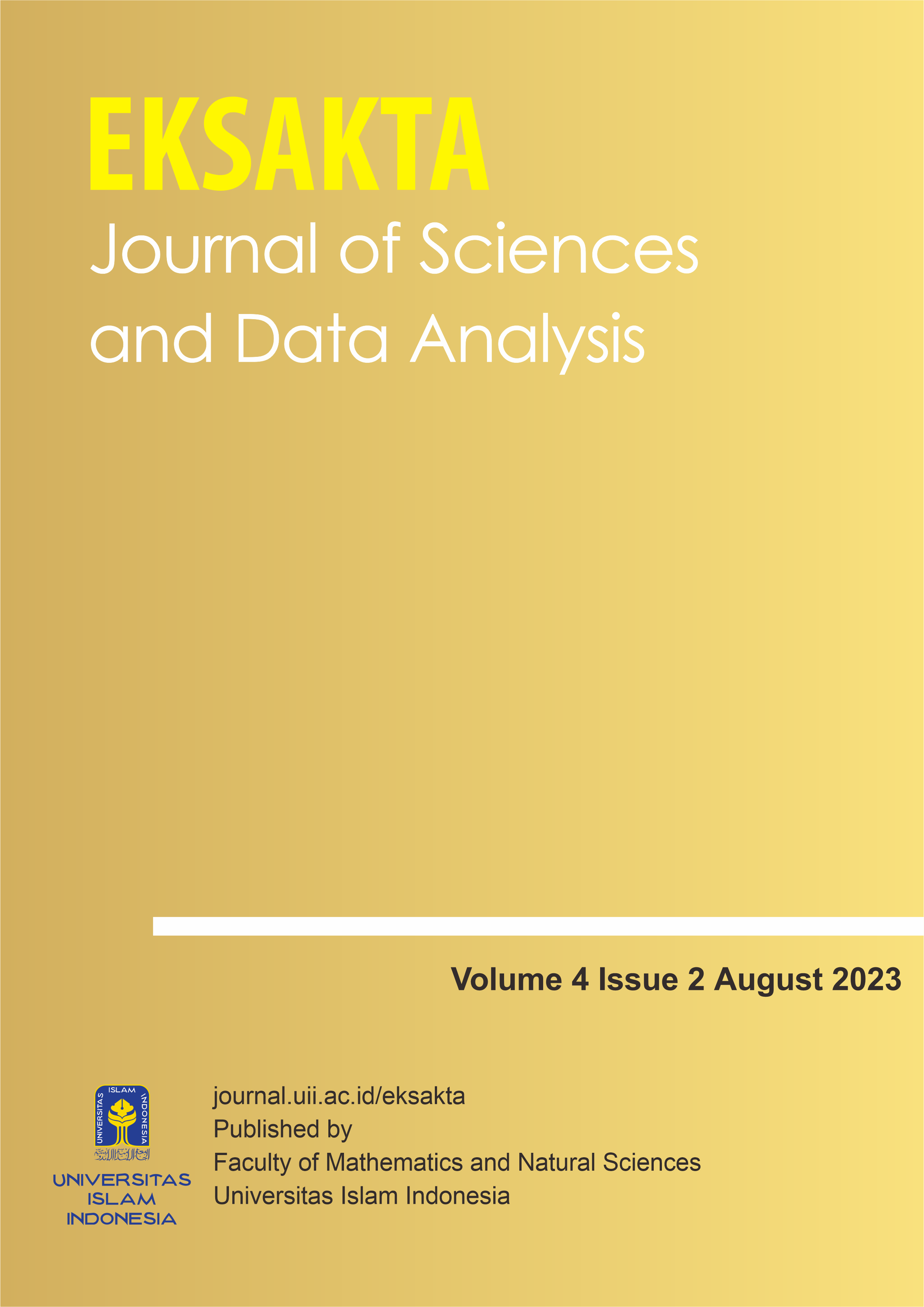Main Article Content
Abstract
Abstract: One of the problems encountered in the forecasting process is the problem of heteroscedasticity. Heteroscedasticity occurs a lot, especially in stock data. Pt Share Price Indosat (tbk) from March 6 2012 – January 18 2022 has fluctuated from time to time, so the variance is heteroscedasticity. The Generalized Autoregressive Conditional Heteroskedasticity (GARCH) model and Artificial Neural Network Backpropagation (ANNBP) are methods that can be used on data with heteroscedasticity. The aim of this research is to obtain models and forecasting results from GARCH and ANN Backpropagation. In this study, the two models were compared based on the smallest MAPE value. This study uses daily data on the closing of Indosat shares. Forecasting is done on Indosat stock closing data, the total data is 2453 data divided into two parts, namely 80% training data totaling 1962 data and 20% training data totaling 491 data. Forecasting results from the GARCH model obtained a MAPE value of 11.04%, and the ANN Backpropagation model with 7 input layers, 20 hidden layers, obtained a MAPE value of 7.01%. Thus, the best model for predicting Indosat's share price in this study is the backpropagation model.
Keywords
Article Details
Authors who publish with this journal agree to the following terms:
- Authors retain copyright and grant the journal right of first publication with the work simultaneously licensed under a Creative Commons Attribution License that allows others to share the work with an acknowledgment of the work's authorship and initial publication in this journal.
- Authors are able to enter into separate, additional contractual arrangements for the non-exclusive distribution of the journal's published version of the work (e.g., post it to an institutional repository or publish it in a book), with an acknowledgment of its initial publication in this journal.
- Authors are permitted and encouraged to post their work online (e.g., in institutional repositories or on their website) prior to and during the submission process, as it can lead to productive exchanges, as well as earlier and greater citation of published work (See The Effect of Open Access).
References
- Arfani Irawan, D. (2012). Banking Performance Measurement Based on Balanced Scorecard Analysis at PT. Bank Mandiri (Persero) Tbk.
- Ariefianto, M.D. (2012). Econometrics: essence and applications using EViews.
- Azadeh, A., Moghaddam, M., Khakzad, M., & Ebrahimipour, V., (2012). A flexible neural network-fuzzy mathematical programming algorithm for improvement of oil price estimation and forecasting. Computers & Industrial Engineering, 62(2), 421-430.
- Bollerslev, T., (1986). Generalized autoregressive heteroskedasticity. Journal of Econometric 52, 307-327.
- Bollerslev, Tim. (1988). On the correlation structure for the generalized autoregressive conditional heteroskedastic process. Journal of Time Series Analysis, 1988, 9.2: 121-131.
- Donaldson, R. G., & Kamstra, M. (1997). An artificial neural network-GARCH model for international stock return volatility. Journal of Empirical Finance, 4(1), 17-46.
- Hasanah, P., Nasir, S. Q., & Subchan, S. (2019). Gold return volatility modeling using GARCH. Indonesian Journal of Mathematics Education, 2(1), 20-26.
- Kingsley, A., & Peter, U. (2019). Volatility modelling using ARCH and GARCH Models: A case study of the nigerian stock exchange. International Journal of Mathematics, Trends, and Technology, 65(4), 58-63.
- Sharma, P., & Vipul. (2015). Forecasting Stock Index Volatility with GARCH models Studies In Economics And Finance , Vol. 32, No. 4, pp 445-463.
- Suhartono, M. Sutojo, 2010, "Artificial Intelligence", Andi Yogyakarta. 1st edition.
- Tealab, A. (2018). Time series forecasting using artificial neural networks methodologies: A systematic review. Future Computing and Informatics Journal, 3(2), 334-340.
References
Arfani Irawan, D. (2012). Banking Performance Measurement Based on Balanced Scorecard Analysis at PT. Bank Mandiri (Persero) Tbk.
Ariefianto, M.D. (2012). Econometrics: essence and applications using EViews.
Azadeh, A., Moghaddam, M., Khakzad, M., & Ebrahimipour, V., (2012). A flexible neural network-fuzzy mathematical programming algorithm for improvement of oil price estimation and forecasting. Computers & Industrial Engineering, 62(2), 421-430.
Bollerslev, T., (1986). Generalized autoregressive heteroskedasticity. Journal of Econometric 52, 307-327.
Bollerslev, Tim. (1988). On the correlation structure for the generalized autoregressive conditional heteroskedastic process. Journal of Time Series Analysis, 1988, 9.2: 121-131.
Donaldson, R. G., & Kamstra, M. (1997). An artificial neural network-GARCH model for international stock return volatility. Journal of Empirical Finance, 4(1), 17-46.
Hasanah, P., Nasir, S. Q., & Subchan, S. (2019). Gold return volatility modeling using GARCH. Indonesian Journal of Mathematics Education, 2(1), 20-26.
Kingsley, A., & Peter, U. (2019). Volatility modelling using ARCH and GARCH Models: A case study of the nigerian stock exchange. International Journal of Mathematics, Trends, and Technology, 65(4), 58-63.
Sharma, P., & Vipul. (2015). Forecasting Stock Index Volatility with GARCH models Studies In Economics And Finance , Vol. 32, No. 4, pp 445-463.
Suhartono, M. Sutojo, 2010, "Artificial Intelligence", Andi Yogyakarta. 1st edition.
Tealab, A. (2018). Time series forecasting using artificial neural networks methodologies: A systematic review. Future Computing and Informatics Journal, 3(2), 334-340.




